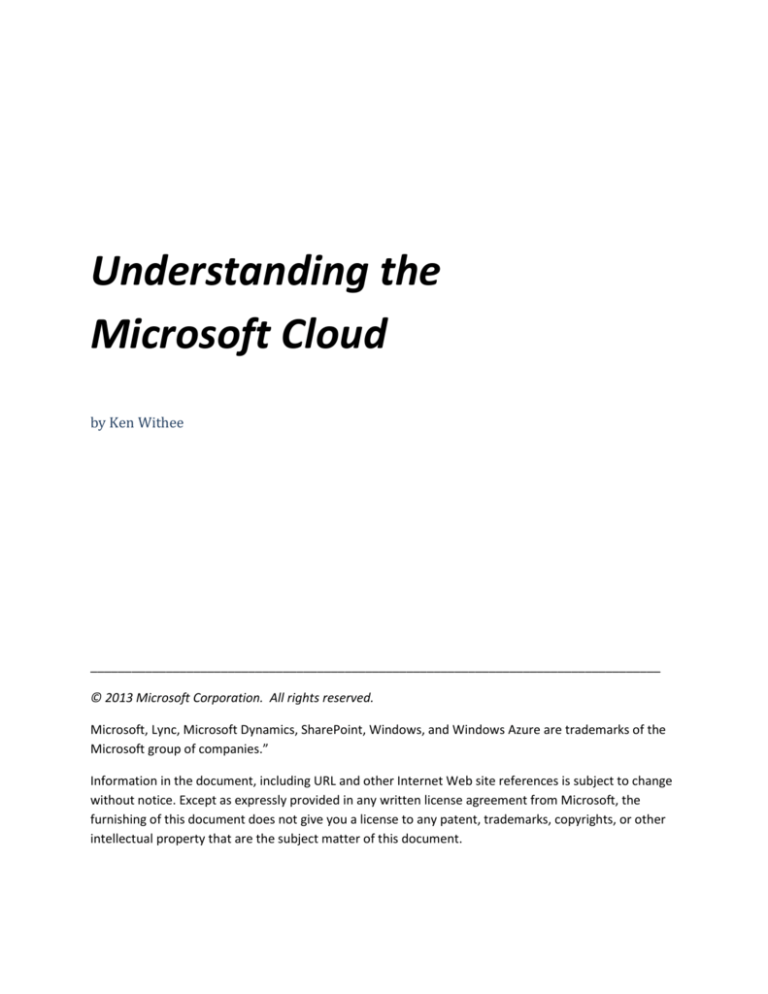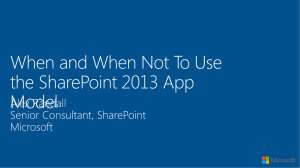
Understanding the
Microsoft Cloud
by Ken Withee
___________________________________________________________________________________
© 2013 Microsoft Corporation. All rights reserved.
Microsoft, Lync, Microsoft Dynamics, SharePoint, Windows, and Windows Azure are trademarks of the
Microsoft group of companies.”
Information in the document, including URL and other Internet Web site references is subject to change
without notice. Except as expressly provided in any written license agreement from Microsoft, the
furnishing of this document does not give you a license to any patent, trademarks, copyrights, or other
intellectual property that are the subject matter of this document.
Understanding the cloud
Trying to understand what a company means by a ‘cloud’ offering can seem like trying to understand
fog. The term ‘cloud’ has come to mean different things to different people. Much of the confusion can
be chalked up to marketing teams embracing the momentum of the ‘cloud’ buzzword. In the end, the
benefit of the ‘cloud’ is that you offload the burden of server infrastructure and maintenance, and you
are left with a simple, straightforward cost structure.
The term ‘cloud’ is nothing new. Back in the early days of computer networks, engineers would need to
map out all the components of a network. As networks became bigger and more complex it became
impossible to map everything out in a single diagram. To accommodate the diagramming of complex
computer networks, engineers developed a shortcut. Whenever a computer would talk to another
computer across a complicated network the engineers would simply draw an abstraction for the
network in the form of a cloud shape like this:
The cloud shape thus became analogous with a complicated computer network. The largest computer
network of all is of course the combination of networks and computers that make up the Internet.
Mapping the Internet network isn’t possible, so whenever someone needs to reference a computer
talking to another computer over the Internet, they use a cloud shape. For example, let’s say you want
to show how a person at their home checks her Hotmail account. She logs in to her computer and then
opens the Hotmail webpage. The server hosting the Hotmail service is located in a Microsoft data center
and is accessed over the Internet as shown here:
2
In fact, email was one of the first widely used cloud-based software services. If you have ever used one
of Microsoft’s email services like Hotmail or Live then you have already used the Microsoft cloud. Now
enterprise class business software like SharePoint, Exchange, Lync, Project Server, and Dynamics are
finally moving to the cloud-based model as well.
The shift to cloud-based software
In the past, software companies like Microsoft would only sell licensing for their products. Organizations
would pay for the licensing and then their engineers would buy computers and install the software. The
nature of the Internet, being always available, opened a massive door of opportunity. With the Internet,
a company like Microsoft can now install its software in its own data centers and then customers can
access and use the software over the Internet. This has some major benefits for both customers and the
software company. For customers, it removes the complexities that come with installing and managing
enterprise-class software. For the software company, it allows the same engineers that develop the
software to fully integrate with its installation and management, as shown in the next picture. The result
is that Microsoft gains control over the functioning of the software and ensures an optimized
environment and better customer experience.
3
Looking through the cloud
Microsoft has fully embraced the new cloud-based software paradigm and has spent billions of dollars
building out state-of-the-art data centers around the world. The data centers are where the computers
that run Microsoft’s cloud offerings are physically located. These include massive amounts of computer
power housed in bunker-like structures, as shown here:
4
Microsoft has staked its entire reputation on this new software paradigm. To ensure that things run
smoothly, Microsoft has built technology into the base operating systems specifically designed for
offering software over the Internet. The Windows Server advertisement shown here specifically calls out
that it was built for the cloud.
5
What does "built for the cloud" mean? It means the operating system now includes built-in functionality
for multiple levels of redundancy, backup, recovery, and virtualization. For example, if a physical
computer crashes, another computer in the data center automatically takes over and the users are not
affected. The same redundancy holds true at the entire data center level. Should a natural disaster hit
one data center, another one, in another part of the country, or world, automatically accepts the user
load and take its place. From the customer point of view, the software continues to operate as
expected. This level of engineering is required for modern software delivered over the Internet.
Benefits of cloud-based software
Organizations can now think of enterprise-class software the same way they think of electricity in their
home. That is, they don’t really think about how it works, they just know that it is on and available when
they need it. In this sense, it is a natural progression in software.
To take the analogy further, can you imagine if your organization had to be responsible for its own
electricity generation and management? The amount of resources you would have to dedicate to the
task of generating your own power would be enormous and cost-prohibitive.
Sure, it is possible to build a power generation station and run wires and install transformers and all that
comes with electricity. The cost and complexity entailed would surely put electricity out of reach for all
but the biggest organizations. With our modern electric grid, any size organization or individual can avail
itself of all of the benefits of electricity without the burden. The organization simply signs up for electric
service and the electric company takes care of the rest.
6
Software delivery over the Internet follows this same example. Organizations don’t have to expend the
resources required to install and maintain enterprise software on their own. They can simply sign up and
tap into the existing software service within minutes:
7
Cloud-based software categories
Microsoft has a number of cloud-based offerings, and this often creates confusion. The offerings all have
their pros and cons, but taken together as a single lump it can be overwhelming to understand how they
all fit together and how they can be used. Cloud-based software falls into three primary categories:
Software as a Service, Platform as a Service, and Infrastructure as a Service.
When deciding to adopt a software solution, it is important to consider all of your options. For example,
let’s say you are thinking about adopting a Microsoft SharePoint solution for your organization. You
have heard about cloud offerings but aren’t really sure how things like Azure fit in with Office 365 or
what it means to install On-Premises. What you need is a solid understanding of your options so that
you can make the right decision for the circumstances of your organization.
There are four primary scenarios you need to investigate when thinking about a SharePoint solution for
your organization.
Option
You can choose to purchase the
software on a subscription basis
and access it over the Internet.
You can choose to take
advantage of infrastructure
such as the operating system
and database hosted by
Microsoft but install and
manage the SharePoint solution
yourself.
You can choose to purchase the
software licensing and pay your
own personnel to install and
manage it locally.
Description
This is called Software as a
Service (SaaS) and the offering
by Microsoft is called
SharePoint Online, which is part
of a bundle of products
collectively known as Office
365. In addition to SharePoint
Online, the Office 365 bundle
also includes Exchange Online
and Lync Online.
This is called Platform as a
Service (PaaS) and the offering
by Microsoft is called Azure.
Type
Software as a Service
This is called On-Premises
software since you have the
entire stack of hardware and
software on the premises of
your organization.
On-Premises / Infrastructure as
a Service
Additionally, you could
purchase virtual computers and
access those virtual computers
over the Internet. You would
still be responsible for hiring
your own personnel to install
8
Platform as a Service
You can choose a combination
of the previous options in a
"hybrid" approach.
and maintain SharePoint Server.
The difference here would be
that the computers they would
use to do it would be
virtualized. This scenario is
called Infrastructure as a Service
(IaaS).
This is a combination of using
Hybrid
SharePoint Products in various
capacities: using SharePoint
Online, Azure, or On-Premises
SharePoint Server.
Software as a Service model for SharePoint Online
The most straightforward way to implement SharePoint is to sign up for Office 365, which includes
SharePoint Online. Office 365 is a bundle of products that are fully managed and maintained by
Microsoft at its data centers and accessed over the Internet by customers. This is known as the Software
as a Service (SaaS) model because the software is available and ready to use instantly. There is no need
to install SharePoint Online. You sign up for it and can start using it within minutes. The major benefit to
this service is that it is purchased per user so you can begin using SharePoint Online with a single user or
scale up to tens of thousands of users. In the past, using a SharePoint solution for a small organization
was unheard of because of the overhead involved in implementing the software.
Other Microsoft products that are offered using the Software as a Service model include Exchange, Lync,
Project, and Dynamics CRM. To learn more about these offerings, see http://office.microsoft.com/ and
http://www.microsoft.com/en-us/dynamics/crm.aspx.
9
Platform as a Service model for SharePoint Server
If you have an established IT team that wants full control over SharePoint but doesn’t have the
bandwidth to manage the rest of the infrastructure, then Azure fits the bill. Azure provides a platform
on which you can install SharePoint Server. The platform includes the operating systems and databases
but you install and manage SharePoint Server on this platform. This gives your IT team full control over
SharePoint Server but abstracts the underlying infrastructure platform. The infrastructure platform runs
in Microsoft data centers and your team is responsible for installing and running SharePoint Server on
that platform.
In addition to an operating system and database platform on which you can install SharePoint Server,
Azure can also be a platform for other functions such as running .NET code in the cloud or performing
identity management to name a two examples. To learn more about Windows Azure, see
http://www.windowsazure.com/.
On-Premises model for SharePoint Server
An On-Premises implementation is where you install SharePoint Server on your local server computers
and manage the entire thing with your own personnel. Because SharePoint Server is installed on servers
on your organization's own premises it is called an On-Premises implementation. This has been the
primary means of using enterprise software in the past. Because of the resource requirements and high
cost, it is generally only large organizations with mature IT departments that are able to avail
themselves of server products like SharePoint Server using an On-Premises model.
10
<Note> We haven’t mentioned Infrastructure as a Service, but it is similar to the On-Premises model.
The difference is that instead of purchasing physical servers and installing the operating systems and
software yourself, you purchase virtual servers. Amazon and other companies provide virtual servers to
accommodate this model. When you create a virtual server on Windows Azure, you are free to do with
it as you please. You might decide to install the Linux operating system instead of Windows Server. Think
of a virtual server just like you would think of a physical server but accessed over the Internet. You
create the virtual servers and then use them just like you would if they were physical servers on your
own premises.
The Windows Azure Infrastructure as a Service offering is called Windows Azure Virtual Machines. For
more information, see http://www.windowsazure.com/en-us/services/virtual-machines/. For
information specific to using SharePoint Server with a Windows Azure Virtual machine, see:
SharePoint 2013 on Windows Azure Infrastructure Services
SharePoint 2010 Deploying on Windows Azure Virtual Machines
Hybrid model for SharePoint Products
A hybrid option is where you use SharePoint Server on your local premises for some requirements
within your organization and use SharePoint Online or SharePoint Server installed on Azure for other
requirements. The hybrid approach assumes that your organization has the IT resources to manage an
On-Premises implementation. A common scenario involves offloading some of the standard business
uses of SharePoint to the cloud offerings and maintaining an On-Premises implementation as well for
internally built and highly customized solutions that rely on SharePoint functionality.
11
Keep in mind that with a hybrid approach, you can mix and match in any number of scenarios. For
example, in the diagram, an organization maintains a local On-Premises SharePoint implementation for
some parts of its business. It also subscribes to Office 365 and uses SharePoint Online as a service, and it
has also installed and run SharePoint on Windows Azure. Alternatively, it might choose not to have a
local, On-Premises implementation of SharePoint Server but still have an implementation of SharePoint
Server on Azure. In this scenario, the organization would deploy highly customized applications to an onpremises installation of SharePoint Server while using SharePoint Online for general business use and
document management.
<Important> The important point to note is that a hybrid approach does not follow any strict guidelines.
A hybrid approach can be any combination of using SharePoint Products across the different offerings.
Conclusion
A decision about the best way to adopt enterprise software is dependent on many factors. As a decision
maker, your job is to understand the options and then make the best decision for your organization.
Determining cost for each option can be difficult. For an On-Premises solution, the licensing costs alone
might look less expensive than licensing for Office 365. However, the On-Premises solution also needs to
take into account the people and infrastructure required to install and maintain the software.
"Infrastructure" can be a deceptively simple word. Infrastructure includes security, high availability,
backup and restore options, and disaster recovery. It also includes data center space and cooling
systems and power redundancy.
Getting a grasp on the infrastructure involved in implementing enterprise software can be daunting and
difficult to fully understand. The nature of infrastructure is one of the primary business drivers in moving
to the cloud. It is very easy to calculate the cost of an Office 365 solution. The cost for Office 365 is
calculated per user and the infrastructure burden is offloaded to Microsoft. Calculating the true cost of
an On-Premises solution is a guess at best because you don’t know what you don’t know. The cost might
be thought to be one figure and then the team realizes that it did not take into account a disaster
12
scenario where the data center loses power completely. In this scenario the team would need to add on
a geographically separated data center to accommodate data integrity policy within the organization.
With a Software as a Service solution such as Office 365, the costing exercise is simple and
straightforward and the infrastructure burden is shifted to Microsoft.
13







